The ancient Slavic culture has everything you need to create and maintain a happy, healthy and prosperous life. The key role here is played by amulets - items with magical powers, which protects from evil forces and opens the way to harmony with life and nature.
The Slavs made amulets from various natural materials. Animals, symbols, and deities were painted on the products. Each symbol has its own meaning.
Amulets were used at home, men and women carried them with them, because these symbols protected against misfortunes and illnesses. Thanks to the amulet, a person received contact with higher powers .
Meanings of amulets
 The Slavs used amulets to protect their homes. The items were placed in the house, near the entrance and in vulnerable places. Women, the keepers of the hearth, often remained at home and on the farm; they needed the protection that amulets gave them: pendants with images of birds and animals. And pendants with a bear protected them from the evil eye and evil. Sometimes women wove a comb with the image of birds into their braids.
The Slavs used amulets to protect their homes. The items were placed in the house, near the entrance and in vulnerable places. Women, the keepers of the hearth, often remained at home and on the farm; they needed the protection that amulets gave them: pendants with images of birds and animals. And pendants with a bear protected them from the evil eye and evil. Sometimes women wove a comb with the image of birds into their braids.
The comb gave health. It was also used for magical rituals: if someone was sick at home, they combed their hair, and then put this object in a holy place for a week. Protective earrings with an ax and ax showed evil that their owner was under divine protection.
Careful needlework occupied a special place in Slavic culture. Women embroidered on tablecloths, towels, napkins that were passed down from generation to generation. Protective symbolism was also applied to clothing. Not only the place where the symbol was embroidered was considered important, but also what it was done with, what material was used and what color.
You cannot embroider a talisman for personal use, nor do you make protective items at someone’s request. No knots are needed for embroidery, because... this interferes with the exchange of energies between the owner and the amulet. You can embroider one amulet pattern on one item.
The symbols made by parents and children, sisters and brothers, and spouses had the greatest power. Power manifested itself if they felt a spiritual need to create a talisman.
 A strong sign is Symbol of the Family. This Slavic amulet is considered the most powerful. The one who had this sign preserved the power of the family, passing it on to descendants. The Family symbol activates the ancestral connection between ancestors and descendants.
A strong sign is Symbol of the Family. This Slavic amulet is considered the most powerful. The one who had this sign preserved the power of the family, passing it on to descendants. The Family symbol activates the ancestral connection between ancestors and descendants.
Protective knots helped to cope with difficulties and troubles. Magical “knows” were used by men and women. To fill the amulet with power, it had to be made by the person himself from hemp and nettle. Nauzes were kept in the house and worn with clothes as decoration.
The amulets were made from different metals: silver ones had powerful protection. The amulet that was carried with them must have a closed form (rings, bracelets, necklaces, pendants). In order for the protective item to have greater power, it had to be worn without taking it off. Then the protection increased many times.
Used as a talisman bones and teeth predatory animals. They were used to protect against evil; hunters especially often carried them with them.
 Slavic amulets hold a special, deep and sacred meaning. Protective symbols and ancient Slavic security items - power, life force, connection with nature. Therefore, the talismans of Slavic culture have strong protective properties. They protect homes, take them with them on the road, use them in everyday life, and use them to protect families and relatives.
Slavic amulets hold a special, deep and sacred meaning. Protective symbols and ancient Slavic security items - power, life force, connection with nature. Therefore, the talismans of Slavic culture have strong protective properties. They protect homes, take them with them on the road, use them in everyday life, and use them to protect families and relatives.
The Slavs divided protective protective symbolism into male and female. In each family, the oldest woman did this. She made protective amulets in silence so that all her thoughts were clear and bright.
The basis of magical objects are symbols. They can be applied in the form of embroidery, carved on wood, household items, or applied to metal jewelry.
Lunnitsa
This sign keeps women's health. Protects pregnant women and sets them up for a successful birth. Through this symbol, the child receives strong support from his Family. The amulet symbolizes life.
Yarilo
Yarilo is a universal sign used by men and women. Mascot keeps love, strengthens the family unit. Adjusts for harmony, mutual understanding, prosperity, protects the family.
Lada
Lada the Mother of God symbolizes love, youthful freshness, and beauty. Protects the house. The amulet was worn by girls who wanted family happiness.
Alatyr
Alatyr is a sign that symbolizes power over time. The talisman is traditionally female. It was more often used by young girls who created powerful protection for their Clan.
Makosh
Amulet for married women, which honor family traditions, keep kindness and warmth. Makosh protects the family, the hearth and each family member. Gives happiness and abundance.
Overcome-grass
It has magical powers and is a powerful defense against demons. Protects from diseases.
Wedding party
![]() The sign of the newlyweds, it was given to the bride as the future keeper of the hearth. After the wedding wife took care of family values, was responsible for maintaining home well-being and harmony.
The sign of the newlyweds, it was given to the bride as the future keeper of the hearth. After the wedding wife took care of family values, was responsible for maintaining home well-being and harmony.
The wedding dresser protects the young family from the evil eye and damage. Attracts goodness and bright energy.
Molvinets
Molvinets helped preserve the family, contributed to bearing children, set me up for a simple birth. The talisman protects the newborn. This sign was worn all my life.
Woman in labor
Women who wanted children carried this sign with them. Protects newborns and helps women prepare for childbirth.
Seal of Veles
Protects hunters, protects them from accidents and risky adventures.
Vseslavets
Protects from quarrels keeps the peace between Clans, transforms forces for good. Helps in endeavors, protects against fire, preserves material property.
Doukhobor
A talisman of life, helps cleanse the spirit and physical body. Protects against diseases. Gives vigor and increases energy levels. Promotes productive work in business and at home.
 Amulet of warriors who protect their Family. Keeps family traditions.
Amulet of warriors who protect their Family. Keeps family traditions.
Men need amulets for good luck in business, for protection during the hunt, they set you up for a prosperous family life. The Slavs wore amulets on their shirts and bracelets.
The talisman made by the wife receives the most power. Sometimes Slavic women wove bracelets for their husbands from their own hair. Such talismans kept men safe during campaigns and everyday life.
Kolyadnik
Male Caroler worn from an early age, because this symbol gives wisdom, resourcefulness, flexibility of mind and ingenuity. The symbol of the god Kolyada means the constant renewal of the world, the victory of light. Women can wear this symbol only for courage and confidence. For constant use The amulet is suitable for men who are carriers of ancestral memory, because they are the ones who create impulse in the Universe.
 A powerful symbol. It was worn by warriors. Thanks to this amulet man receives wisdom, nobility, honor, justice, protects the Family and the land. Valkyrie smoothes out negative warlike energies and gives peace. Carries life-giving solar energy.
A powerful symbol. It was worn by warriors. Thanks to this amulet man receives wisdom, nobility, honor, justice, protects the Family and the land. Valkyrie smoothes out negative warlike energies and gives peace. Carries life-giving solar energy.
Gives blessings to warriors and instructs in wise resolution of conflict issues. A universal symbol that brings together intelligence, wisdom and courage.
Yarovik
Security amulet. It is used to protect the farm from various influences. Saves what you have acquired material good. Protects from the negativity of the surrounding world. Protects livestock from diseases, thieves, and natural disasters. Transforms energy into prosperity and goodness, protects the harvest. Yarovik was applied over the room where the grain was kept.
fern flower
Perun's color protects from the evil eye, damage, and disease. Destroys the action of dark forces. Invulnerable to evil. Helps its owner find treasure and fulfills wishes. Reveals spiritual powers.
Dolls
![]() The dolls had great power and were not toys, but served as a powerful amulet. Most of the dolls were associated with female deities, some with male ones. The mother made the Kuvatka doll during pregnancy, so that after the birth of the baby, the amulet protected the child from any troubles.
The dolls had great power and were not toys, but served as a powerful amulet. Most of the dolls were associated with female deities, some with male ones. The mother made the Kuvatka doll during pregnancy, so that after the birth of the baby, the amulet protected the child from any troubles.
There were also cleansing dolls that collected the troubles and illnesses of their author. After making the doll, they threw it into the fire, where the troubles were burned.
They made dolls from fabric and threads without the use of scissors and needles. You only need to spin the amulets dolls in good mood, otherwise this talisman will harm the owner. Before making it, the house was cleaned, the women dressed up and performed the sacrament. The doll did not have a face. Protective dolls were kept away from prying eyes and passed on to the heirs along the female line.
Charms were made to protect life, health, family well-being, the discovery of talents and the gift of clairvoyance.
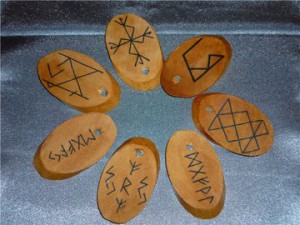 To make a talisman, you need to start creating it in a good mood. Not at someone’s request, but when there is an inner spiritual desire to make a protective amulet. Then there will be a talisman endowed with powerful strength and protection from negativity will become the basis for receiving beneficial energy.
To make a talisman, you need to start creating it in a good mood. Not at someone’s request, but when there is an inner spiritual desire to make a protective amulet. Then there will be a talisman endowed with powerful strength and protection from negativity will become the basis for receiving beneficial energy.
You can make protective signs for your family and relatives. In other cases, it is impossible to produce protective amulets, because it will not bring the desired benefit. Make them for yourself and those closest to you (husband, children).
It is better to make a protective amulet alone, when no one will disturb you or distract you. Turn off the phone, ringing. Step away from everyone, tune in to spiritual harmony and peaceful well-being. Then the amulet will receive powerful power and will serve faithfully.
You need to make a metal amulet only from silver, gold. Silver is a priority, because this material is easily filled with energy. Gold is better suited for purifying or transforming flows.
You can also make amulet made of stone, wood. But this requires a lot of effort. Go into the forest for a twig, accompany this process with rituals (in other cases, the material will be just a thing and nothing more). Crystal is a very energy-intensive material, but is not suitable for amulet. Therefore, it is easier to make a talisman from silver or embroider it on fabric.
The amulet must be mirror-like (end-to-end): on one side it must be the same as on the other. Then a harmonious energy exchange will occur.
The lines of the amulet must be clearly drawn (without “jumpers” or burrs). The schematic requirements must not be neglected (observe the degrees of inclination, the smallest lines and bends), each element is an energy conductor and has a special meaning.
How to choose a talisman by date of birth
 In addition to the classic meanings of amulets, there are amulets based on date of birth. They were selected based on ancient Slavic zodiacs. There are 16 of them in total, they are called palaces. These include the following palaces:
In addition to the classic meanings of amulets, there are amulets based on date of birth. They were selected based on ancient Slavic zodiacs. There are 16 of them in total, they are called palaces. These include the following palaces:
- Virgo (28.08-20.09) - apple tree, goddess Jiva (Alive);
- Boar (20.09-12.10) - pear tree, supreme god Ramhat;
- Pike (12.10-03.11) - plum tree, goddess Rozhana;
- Swan (3.11-24.11) - pine tree, goddess Makosh;
- Serpent (11.24-12.17) - linden tree, Semargl-firegod;
- Raven (12.17-8.01) - larch tree, god Varun;
- Bear (01/08-02/01) - raspberry, the highest god Svarog;
- Stork/busla (01.02-20.02) - willow tree, god Rod;
- Wolf (25.02-22.03) - poplar, god Veles;
- Fox (22.03-15.04) - hornbeam, currants, goddess Madder;
- Tour (15.04-07.05) - aspen, the highest god Kryshen;
- Elk (05/07-05/30) - birch, goddess Lada;
- Finist (30.05-21.06) - cherry, god Vyshen;
- Horse (21.06-13.07) - fern, god Kupala;
- Eagle (13.07-04.08) - oak, god Perun;
- Race (04.08-28.08) - ash, god Dazhdbog.
Each palace has its own amulet. Therefore, you can make a protective amulet based on your date of birth. If a person does not know when exactly the person for whom the amulet is being made was born, the Slavs selected protective symbol according to intuition.
A talisman is not only a physical object created for protection. In it energy charged, it is also a “vessel” for the energy around. It works on reception and return. Therefore, the owner of the amulet must seek harmony with the world around him, develop spiritually and do good. Then protective symbols will help you achieve your goals, maintain your health and open the way to happiness.
Their magic was undeniable in ancient times, and it is not diminished even today. These items are united by their primary purpose - to protect the owner from disasters. But talismans are capable of performing other functions. The magical effect of these items is different, as is their manufacture. Only a dedicated magician, observing ritual rites, makes powerful amulets for a specific person for specific purposes. And it is not always possible to make talismans with your own hands - it is best to receive them as a gift or buy them ready-made, in accordance with the advice of astrology. The most effective amulets are those made for you by the hands of loving blood relatives.
Etymology of words
Amulet is a Slavic word, the root of which is “shore”. This is the name of the border between the dangerous unpredictable element of Water (sea) and the relatively safe element of Earth. By landing on the shore, the shipwrecked people saved their lives. The practical purpose of this item is heard in the word itself - to protect.
Amulet is a Latin word. Possibly derived from the phrase moli letum, which translates as “turn away death.” It is impossible not to take into account another hypothesis - from the Arabic hamalet, which means “to wear”: amulets are most often carried on one’s person.
The origin of the word “talisman” usually comes down to two options: from the Arabic talisam, the translation of which is “to create a magical sign,” or from the Greek τέλεσμα (effect, enchantment).

Amulet - what's in the word that?
Let's start with the amulets. And let’s immediately make a reservation that amulets and talismans are embodied in objects of the material world. But amulets are not only things made by man or created by nature. Many of them are verbal: prayers, incantations, spells, whispers. There are amulets-gestures, for example, Stork or swallow nests have long been considered symbols of family happiness and prosperity. A three-haired cat in the house will “insure” against fire. Garlic cloves and even their smell, a pinch of salt thrown through left shoulder will protect from evil spirits. The amulet protects not only the body of its owner, but also the world around him. This item is most often placed in a visible place, unlike an amulet, which is preferably hidden from prying eyes. A spell cast with the intent to “harm” someone, even a villain, is not a talisman. 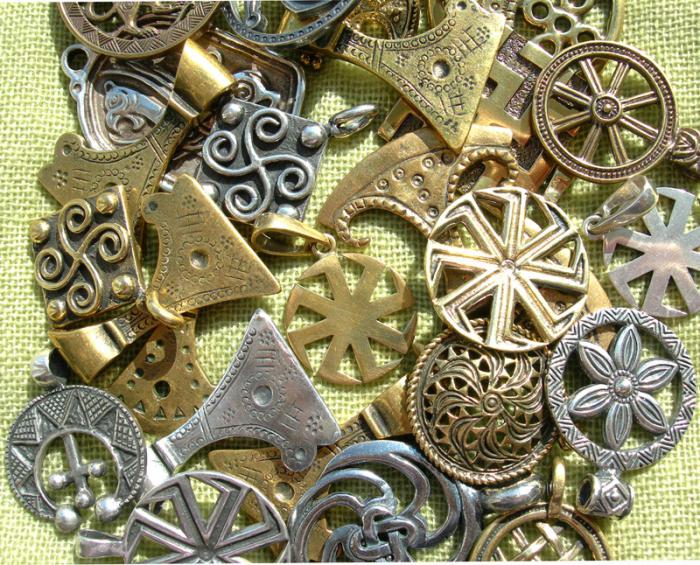
Briefly about amulets
The ancient Roman scientist Pliny (the Elder) in his book “Natural History” gave the following definition of an amulet: “An object that averts trouble from a person.” Many consider this interpretation to be the most correct. The amulet protects against negative influences that can negatively affect luck and health.
For the amulet, a material is selected, a form to express his physical body, and magical symbols to impart energy power. The final stage is a ritual ceremony aimed at reviving the amulet.
The amulet is active in the direction that is inherent in it with a specific thought form, in other words, what it is charged with. The amulet is capable of performing (in addition to protection from visible and invisible enemies) additionally only one specific function - to attract love or good luck, to preserve vitality. Therefore, the statement that a magical item is charged for all occasions is false. The most effective will be the one that performs only one role - protector or assistant. For protection, it absorbs negative energy coming to a person both from outside and inside him. The helper amulet accumulates strength. And, if necessary, it feeds its owner with them. This is an intimate thing, it is hidden from prying eyes, strangers are not allowed to touch it. Know: the evil intentions accumulated in the amulet can be addressed to others, which is what is practiced by unkind people.
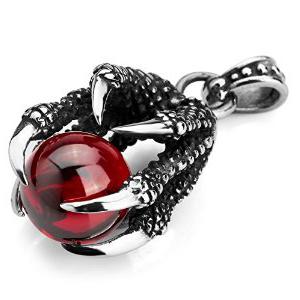
Talisman - magnet of well-being
This item becomes magical after some time of communication with the owner. The talisman has a character, so it is extremely important that it corresponds to the astrological data of the owner of this item. The talisman has no logic, empathy or love for the owner. It has certain properties and specific tasks. It works to attract good luck, financial well-being, increased vitality and sexual attractiveness, and attract success to the person to whom it belongs. The talisman also works inside a person, directing his thoughts and actions in the right direction, strengthening the positive in character and weakening negative traits. But he cannot develop new qualities that were not originally inherent in nature. Most often, gems become talismans. Therefore, it is extremely important to approach the choice of a stone with knowledge of the astrological data of the person to whom it will belong. A talisman can be not only a thing made of some material, but also the image of an object (book, mask, horseshoe), animal (lion, black cat), bird (eagle), insect (grasshopper, ladybug), plants (clover, daffodil). It can be anything with which happy memories are associated (a toy, a tea cup, or even a fragment from it). A talisman cannot be gestures or verbal amulets - prayers, incantations, spells. It is not necessary to perform ritual actions on it. It can be either individual or general (the quatrefoil is the unofficial symbol of Ireland, Olympic symbols).

The meaning of amulets and talismans
Some, most often pessimists and atheists, resolutely do not believe in the power of magical objects, calling amulets and talismans trinkets. Others doubt, not daring to finally make a choice: to believe or not to believe. Still others, superstitious optimists, believe without hesitation.
Let's assume that the theory of the energy capabilities of these objects works. This is amazing! Otherwise, amulets and talismans give self-confidence, and self-hypnosis is a powerful tool. All that remains is to make your own efforts in the right direction to achieve your life goals. And then, you see, you will be rewarded - by faith. Hence the conclusion: amulets and talismans help only those who believe in them magical power.
Simple amulets
In every home there are objects in the protective power of which the Slavic ancestors believed, being pagans. These beliefs have survived to this day.
An ordinary steel pin, enchanted and pinned correctly (preferably 2, fastened crosswise from the inside of clothing against the solar plexus or heart), becomes a talisman against the evil eye and envy.
A needle can save a house from an unkind person. You need to thread a white thread 22 cm long into the eye of a needle, fold it in half, and tie 3 knots at the end. Circle the point of the needle around the doorway and stick it behind the jamb at the top, hiding it from view, saying three times: “You, needle, stand guard, don’t let evil and enemies into the house.” Needles in the house must be strictly accounted for. And not because the lost one can get stuck in an arm or leg, but because so that an extra one does not appear in the house, which the unkind one has spoken to envious person to quarrels, discord and other dirty tricks in your family.
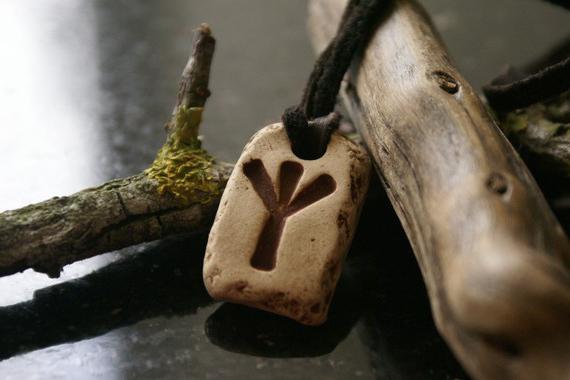
A red woolen thread tied on the wrist of the left hand becomes an obstacle to incoming damage.
A broom is a symbol of cleanliness in the house. If you place it with the whisk down, it will be a talisman against quarrels in the family. If the whisk is facing up, then it will scare away an ill-wisher who enters the house, or will attract monetary wealth. You cannot give the broom to anyone.
A bell - evil spirits are afraid of its ringing. This is the necessary loud and cheerful protector of the home.
The ring is an ancient amulet eternal love, marital fidelity.
Charms-symbols
The Slavs have a great variety of protective patterns, amulets, with which they embroider towels, knit knots, sculpt rings, pendants, and keychains. They are applied in wood carvings to kitchen utensils and other household items. Here are a few examples of amulets-symbols. Patterns such as heart knots, wedding dresser, Mokosh's lunnitsa, and caroler will help in love. The burdock symbol is intended for good luck and happiness. In a fight with death, the “Kolovrat” will be a talisman. A “fighter” can imbue you with courage and bravery. “Odolen-grass” will remove any disease from the soul and body.
Handmade amulets
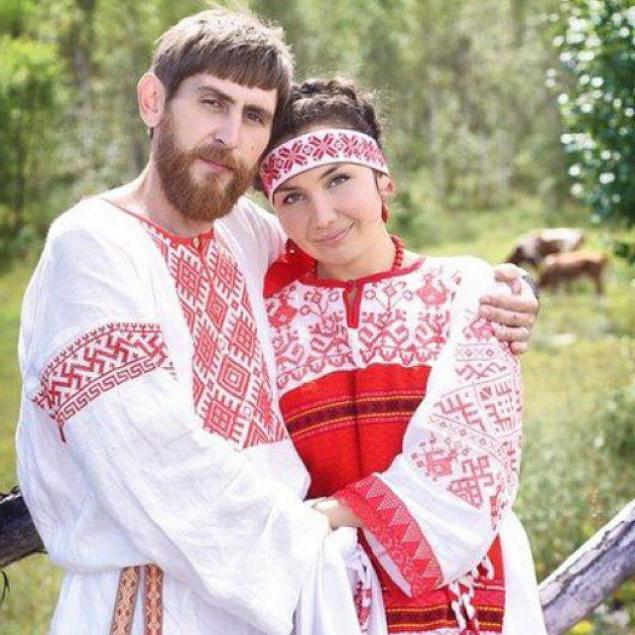
Embroidered towel - family amulet. Previously, such a towel, embroidered with Slavic symbols, was used to decorate houses - where a shelf for icons was attached. The family, sitting down for a festive meal, laid out a long embroidered towel on their knees, which united the relatives.
On the far side, a shirt and a belt will protect your loved one from the vicissitudes of fate, in which feelings of true love and hope for the well-being of the one and only are woven into every stitch of symbolic patterns.
Runes
 A person who firmly stands on the position of materialism considers runes to be ancient cuneiform writing. However, runes are not a simple thing if you perceive them in a fundamentally different way. This is a set of symbols that make up the most magical system ancient world. These are magical talismans and amulets. The Inquisition mercilessly fought against these attributes of the pagan cult - right up to the burning at the stake of those caught wearing a runic amulet. But it was not possible to destroy the runes. They are revered to this day as magical symbols. Amulets, talismans made of stone or wood with runic symbols applied to them are the strongest condensers of spiritual energy that can have an impact on a person and the world around him. This influence can be both positive (protecting and helping) and negative. Therefore, it is better to order from a specialist runic amulets and talismans. You can make such items with your own hands only if you fully understand the meaning of the symbols, manufacturing techniques, ritual rituals (for amulets), which requires sufficient special knowledge.
A person who firmly stands on the position of materialism considers runes to be ancient cuneiform writing. However, runes are not a simple thing if you perceive them in a fundamentally different way. This is a set of symbols that make up the most magical system ancient world. These are magical talismans and amulets. The Inquisition mercilessly fought against these attributes of the pagan cult - right up to the burning at the stake of those caught wearing a runic amulet. But it was not possible to destroy the runes. They are revered to this day as magical symbols. Amulets, talismans made of stone or wood with runic symbols applied to them are the strongest condensers of spiritual energy that can have an impact on a person and the world around him. This influence can be both positive (protecting and helping) and negative. Therefore, it is better to order from a specialist runic amulets and talismans. You can make such items with your own hands only if you fully understand the meaning of the symbols, manufacturing techniques, ritual rituals (for amulets), which requires sufficient special knowledge.
What do the symbols mean?
 Talismans and amulets, photos of which are given here, have magical powers thanks to the symbols. What do they mean?
Talismans and amulets, photos of which are given here, have magical powers thanks to the symbols. What do they mean?
Let's continue the conversation about runes: each has its own wisdom and energy aimed at achieving a specific goal.
Rune ALGIZ- "Instinctive defense." It will help overcome negative influences, using the potential of hidden forces in a crisis situation, develop new creative ideas and implement them in physically, overcome illusions, finding a “foundation under your feet.”
Rune GIFU (GIFU) symbolizes the "Gift of Time". It will help you manage your time wisely, help you give without regret, but not sacrifice immeasurably, strengthen relationships with loved ones, and help you in dialogue with your higher self.
(ODAL)- “Accomplishment”, it helps:
- develop abilities and choose the area of their application;
- maintain order in thoughts and deeds, find a reliable family;
- honor family ties;
- find a home and property, create family comfort.
But, by and large, only those who know can correctly interpret the meaning of amulets and talismans.
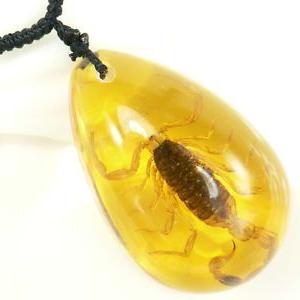
You can see a photo of a complex talisman created by nature - a scorpion petrified in a piece of amber - above. Let's try to decipher its meaning, taking astrological teaching as a basis. The image of a scorpio is a talisman for people born from October 24 to November 22. Scorpio is a dangerous creature, those around him are afraid. He always stands up for his self. Amber is the talisman stone of Leo (birthdays are from July 23 to August 23). But this sunny natural gem is favorable to all signs of the Zodiac without exception - it will charge everyone with its positivity. This talisman will release energy, patching energy holes in the aura of its owner, while simultaneously repelling negativity from the outside.
Feng Shui interior
 Amulets and talismans are appropriate in all rooms of the house. It is easier to achieve success in your career and financial well-being by having an aquarium with goldfish in the northern corner of your home. In the southern zone, place a talisman-picture with a sunrise and a plant with sharp leaves - they will be guardians of the family’s reputation. The East is responsible for happiness family life, mutual understanding between children and parents. An amulet with a dragon figurine hidden in a green plant on a stand will come in handy here. The West is a zone of good luck and prosperity for offspring. Portraits of your children are appropriate here, and if you are childless, then this is a place to place objects of your own creation. The talisman in the western corner could be a large magnet tied with red ribbon. Wake up the energy of the West with bells and striking clocks - they will help in gaining a high position, powerful influence and prosperity.
Amulets and talismans are appropriate in all rooms of the house. It is easier to achieve success in your career and financial well-being by having an aquarium with goldfish in the northern corner of your home. In the southern zone, place a talisman-picture with a sunrise and a plant with sharp leaves - they will be guardians of the family’s reputation. The East is responsible for happiness family life, mutual understanding between children and parents. An amulet with a dragon figurine hidden in a green plant on a stand will come in handy here. The West is a zone of good luck and prosperity for offspring. Portraits of your children are appropriate here, and if you are childless, then this is a place to place objects of your own creation. The talisman in the western corner could be a large magnet tied with red ribbon. Wake up the energy of the West with bells and striking clocks - they will help in gaining a high position, powerful influence and prosperity.
Many people are interested in finding out what the forgotten Slavic objects mean, or more precisely, the amulets that the Slavs used. They were often used in ancient embroidery, in various ancient rites and spells and rituals of Slavic magic. Old Slavic talismans began to return again to the life of Russian people and were actively used in various magic. Their basic meanings, descriptions and principles of action as amulets against evil spirits vary greatly.
All of them are divided into 3 groups:
- Symbols that are used as amulets.
- Ancient Slavic talismans that were used in magic.
- Charms that were often used in magic as guardians of the family.
- Talismans that protected people not only from evil spirits, but also from fires, thieves and misfortunes.
The symbolism of these amulets was different.
This symbol and amulet, reminiscent of a broken cross, was considered the main stone among the Slavic peoples, which patronized many generations. The amulet was used in various rituals that helped procreation, treatment and prevention of various hereditary injuries and diseases, curses and evil influences.
It was given in the hand of women during childbirth, so that the boy or girl would be healthy and strong, and against any deformities and diseases. And the amulet itself was passed down from generation to generation, so that children would be imbued with the wisdom of their ancestors, listen to reasonable and good advice, and they themselves would be reasonable, kind and obedient, perceive all the good things that distinguished their family directly and would not suffer from any mental illnesses.
Sometimes amulets and secret symbols, similar to the birthmark, were passed on to younger children or given as gifts to newlyweds, since now they had the mission of procreation. Usually such a gift was given by the eldest member of the family. And only after this the young people were wished happiness, a good life together and rich offspring.
In addition, this symbol helped make the right and very reasonable decision, so a family talisman made of gold and white metal was always in the house. This Slavic ancient symbol filled the house with reasonable energy and promoted well-being in the family and the world, based on prudence. And the amulet allowed children to study well, gain knowledge and not get into trouble themselves because of their unreasonableness and haste in decisions.
 This talisman, like many ancient Slavic faithful amulets of people of that time, was considered the main talisman for procreation, but unlike the rodovik, it had a slightly different function. If the rodimich protected the wisdom of the Slavs and their intelligence, which was in every family, then the rodimich contributed to well-being on the physical level.
This talisman, like many ancient Slavic faithful amulets of people of that time, was considered the main talisman for procreation, but unlike the rodovik, it had a slightly different function. If the rodimich protected the wisdom of the Slavs and their intelligence, which was in every family, then the rodimich contributed to well-being on the physical level.
It was he who was responsible for preventing the deaths of women during childbirth, the health and wisdom of parents and children, their physical and mental health. Rodimich sharpened intuition and prevented hereditary diseases and various damage that envious neighbors did to babies from generation to generation.
This amulet was worn by each family member around their neck, just as Christians wear a cross, and helped prevent various ailments. Very often it helped against diseases such as:
- pain in various organs;
- drunkenness;
- disobedience of children who could forget the laws of their generation and begin to behave incorrectly.
 That is why rodimich was worn by all relatives in order to be in peace and harmony. Everyone was reliably protected from:
That is why rodimich was worn by all relatives in order to be in peace and harmony. Everyone was reliably protected from:
- evil eye;
- hereditary curse;
- hereditary injuries and diseases that can lead to deformities;
- incurable illnesses resulting from other exposures;
- deviations from family canons and good traditions that Slavic women passed on from the older generation to the younger.
The amulet also has one more meaning. Rodimich was often used for acute infections of children, and in order for old people to live longer, since they could pass on their knowledge to the younger generation and give competent advice at the right time. Therefore, rodimich, like rodovik, were the main amulets in every home. The rest of the amulets were simply an accompaniment, since they were used for the clan. After all, damage to the offspring meant the end of all great undertakings and the fact that the remaining amulets simply would not work as they should.
 The Slavs used it to subjugate all natural elements. It is believed that the amulet ideally helped to pacify all the natural elements that exist on earth. It was his power that pacified the rampant air elements, for example, tornadoes and thunderstorms, protected a person from death on the water, and a house from fires and drought.
The Slavs used it to subjugate all natural elements. It is believed that the amulet ideally helped to pacify all the natural elements that exist on earth. It was his power that pacified the rampant air elements, for example, tornadoes and thunderstorms, protected a person from death on the water, and a house from fires and drought.
This amulet helped against fires that often broke out on Russian soil, but this only happened to pure people who had no sinful thoughts. In this case, the godman protected the home from the natural elements that surrounded it. After all, the people of that time worked in the fields and gardens, so for them a good harvest, protection from fires and rampant water elements, earthquakes and floods was vital, and the name “bogovik” itself meant “god”, a talisman from God, symbolizing nature and its strength.
Slavic magic of that time was based on the influence of the elements on human life, and on methods of controlling them. It was believed that violating these invisible laws of nature, according to which all humanity of that time, including the Slavs, lived, was simply unthinkable.
The well-being of people largely depended on nature and the mercy of its elements. Those who treated her with kind thoughts were protected by higher powers from natural evil.
Sinners who violated the laws of nature and tried to anger the gods could suffer various disasters such as fires, droughts and floods. Therefore, the godman was in every person’s house and the ancient Slavs respected him very much. Charms of this type, like symbols, were created so that the forces of nature do not interfere with a person’s life and creation of his heritage. Therefore, the godman was often hung over the threshold of the house and used as a powerful protection for the hearth from all evil spirits, the wrath of the gods and to protect the home and its inhabitants from the rampant water, air, fire elements, various earthquakes and natural disasters.
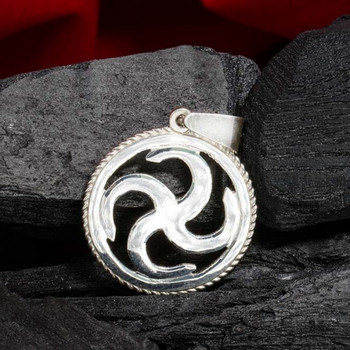 A very interesting symbol and amulet that the Nazis of the German army tried to appropriate for themselves in order to restore their order on Earth. But using it for evil did not end well for them. Their attempts to conquer the Earth ended badly, since objects of Slavic magic cannot be used for evil and in order to harm others.
A very interesting symbol and amulet that the Nazis of the German army tried to appropriate for themselves in order to restore their order on Earth. But using it for evil did not end well for them. Their attempts to conquer the Earth ended badly, since objects of Slavic magic cannot be used for evil and in order to harm others.
The meaning of this amulet is very interesting. The word itself, like the symbol, means the rotation of the sun and the change of seasons, which symbolized the periodicity of the year, the cyclical nature of life and time. There is a similar symbol in the magic of the Tarot, in which it is called fortune, symbolizing the annual cycle and the cycle of life.
The Slavs have amulets and such symbols that are slightly different. The talisman itself indicated not only the annual cycle, but also the continuity of the movement of time and the sun, which the Slavic peoples greatly revered as the mother of all living things. It was on him that their well-being, and the life of an entire people, and sometimes the inhabitants themselves depended. The people of that time depended heavily on the benevolence of the Sun, which the Slavs called the god Yarila.
He provided the weather, controlled the rays of the sun, on which the weather cycle depended, the rains necessary for the Slavs to have a good harvest, and also the mercy of the sun. The good sun contributed to the harvest, the good health of people, especially the elderly, as well as the prosperity of the Slavs, people, their health and well-being.
The evil, unfriendly sun scorched the crops, burned the fruits and destroyed the trees from the heat, contributed to hunger and illness of people, and crop failures. The latter were fatal for people of that time, especially for those who were unable to accumulate grain reserves for the winter or for those who lost their harvest due to the invasion of mice and rats.
So this symbol and amulets were placed in open places in order to appease the Sun God, from whom so much hung in the life of the ancient Slavs of that time.
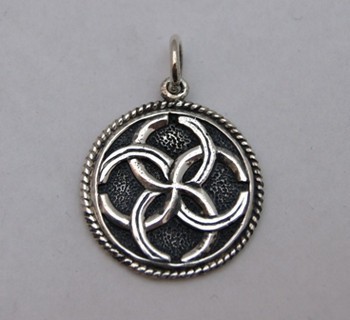 It was used to ensure that the gods protected the family hearth, contributed to the long life of all close people and those who lived together, the life of the young, their goodwill and love, as well as procreation. No wonder this amulet was called a wedding charm, which was given to newlyweds for good luck, so that their family would have peace, prosperity, kindness and all the best.
It was used to ensure that the gods protected the family hearth, contributed to the long life of all close people and those who lived together, the life of the young, their goodwill and love, as well as procreation. No wonder this amulet was called a wedding charm, which was given to newlyweds for good luck, so that their family would have peace, prosperity, kindness and all the best.
The wedding book was kept by the parents until their death, and its duplicates were also given to the new newlyweds on their wedding day, not only for good and harmonious well-being and healthy offspring, but also so that there would be peace and quiet in their home, advice and love.
The meaning of this talisman is great. The amulet strengthened the life of the young couple, contributed to peace and harmony in which they lived for a long time. It is also interesting that it symbolized the power of creation of the race, which was so necessary new family. The more prosperous all the families were, where the talisman was passed on from the older generation to the younger, the stronger the magic was, which protected loved ones from troubles, misunderstanding and the evil eye, as well as failures in their personal lives.
But its significance is not limited to this. The amulet protected the offspring from the so-called ancestral evil spirits, which could gradually destroy a family and create enmity between entire generations. For example, he protected young men and women from unhappy love, unsuccessful marriage or marriage that could end badly for the young. This talisman was given to newlyweds and hung in their bedroom so that it would protect the marital bed.
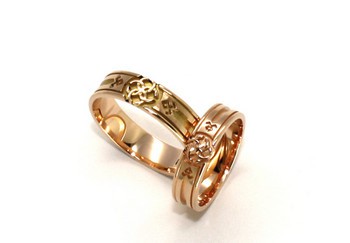 Today this amulet is used again in magic and given to newlyweds who wear Slavic names. It is believed that it will protect them from quarrels and in our time its meaning has changed little. The talisman contributed to:
Today this amulet is used again in magic and given to newlyweds who wear Slavic names. It is believed that it will protect them from quarrels and in our time its meaning has changed little. The talisman contributed to:
- the fact that the young began to respect each other;
- peace and material well-being in family life;
- successful procreation;
- the most beautiful quality - love.
After all, the Slavs believed that only love to the grave protected family ties, making them stronger and stronger, and contributed to the well-being of children and the birth of offspring, but also protected the strength of loved ones, which even the enemies of the Slavs, of whom there were a great many in ancient times, could not resist . This is exactly what weddings began to do, who protected the young from all evil and evil spirits, contributed to their well-being, the development of offspring, the absence of hereditary diseases, and also protected the mother of the children so that the birth process would go smoothly.
The power of this amulet could be increased or decreased. And this was done so that the person would not have troubles, and the young family would be as it should be, and none of the young people would know grief, evil, hatred, or misunderstanding. This is precisely why this talisman was used, so that it would promote peace and harmony, understanding and love.
This amulet was hung over the marital bed and kept until the end of the spouses’ lives. Children who were getting married were given this talisman, and they were also encouraged to get married successfully, so that there would be harmony and peace, love, harmony and tenderness in the family. And also respect for the kids, who were an indispensable attribute happy life Slavs After all, how often in modern families do people quarrel over raising children, because of different views on parental responsibilities and the roles of husband and wife.
During the times of the Slavs, the rules for using amulets were the same for everyone and they contributed to procreation. Their additional protection functions were the ability to influence children. The kids grew up with respect for nature and their parents, family and elders.
Protective amulets contributed to the fact that children revered Slavic gods, who could be very angry for disrespect for their family, for betrayal of their wife and husband, as well as for inattention to children, because they were the successors of the family, its support and strength. The use of talismans has been and remains relevant, despite the total technical equipment of human existence.
In ancient times, people did not know how to explain what was happening around them. Myths and legends came to their aid. All objects and animals were endowed with human qualities. According to our ancestors, they had a soul, had a positive or negative influence on human life and health. Particular importance was attached to rituals, magic spells and symbols. U different nations they were different.
To enhance the protective properties, protective symbols were often embroidered on clothes.
To protect and acquire special qualities, the ancient Slavs used amulets of various shapes. Magic symbols served as ornaments in embroidery and adorned bracelets and necklaces. They were made for women, children, and warriors. In the form of symbols, runes and amulets, they endowed their owner with courage and determination, and filled them with inner strength. Let's look at the famous Slavic amulets, we will find out what meaning, description and interpretation exists.
General and individual Slavic amulets and amulets
Slavic amulets could be placed anywhere: in houses, on household items, clothes, jewelry. Placed inside the hut, it protected the home and each family member, giving them energy and inner strength.

The Slavic zodiac consisted of 16 signs
For individual protection, amulets and amulets were used. The Slavs had sixteen zodiac signs, each with its own symbol. A personalized amulet was chosen based on the birthday of the person for whom it was intended.
Before you put on the amulet with the zodiac, it was necessary. Then its action was directed at a specific person, endowing him with certain qualities. Otherwise, such a talisman would only harm the owner.
To charge the Slavic amulet, all personal information of a person was taken into account, taking into account all individual characteristics. What was important was the name that was given at birth. Personal talismans protected their owner and strengthened him.
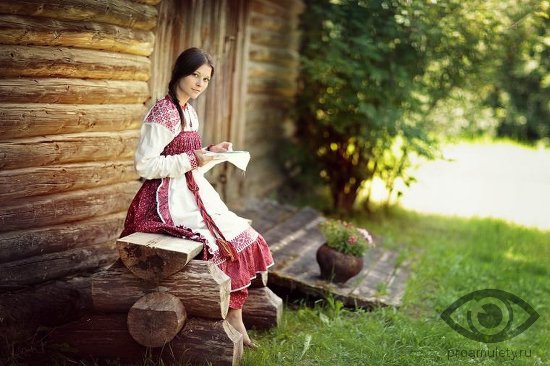
Girls embroidered protective symbols on the clothes of their lovers
When creating Slavic amulets, they were charged to give a person those qualities that he lacks or those that will be useful to him in life. Usually amulets were given as gifts. Mothers made them for their children, girls made them or embroidered them on clothes for their lovers. Amulets were charged with prosperity, good luck, giving courage, protection, etc.
What were Slavic amulets and amulets made of?
Amulets were made from available materials, it could be wood, precious or simple metals. Often the material was animal bones or. The ancestors believed that if you make an amulet from a part of an animal, its power will certainly pass on to you. This Slavic amulet protected the owner from the invisible forces of evil.
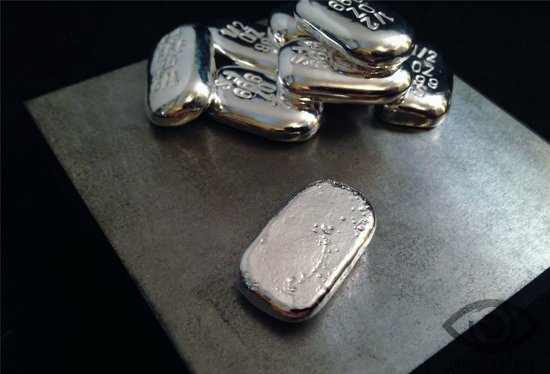
Because of its magical properties, silver has long been used to make amulets.
Popular legends and beliefs say that evil spirits cannot stand silver, so for protective amulets This metal was chosen. The material from which amulets were made performed another important function - determining status. The most valuable were metal products, especially gold.
The main amulets of the Slavs and their meaning
Slavic amulets were used as protection against evil forces and enemies, and were used in magical rituals and ceremonies. They could be intended to protect housing and its owners, separately for men and women. There were also personalized bracelets and amulets that were intended for a specific person. They were not chosen at random, and not for their beauty. Each sign had certain magical properties, which must correspond to their owner.
Among the main symbols for amulets are the following:
- Agni;
- Talisman of Belobog;
Agni is the main sign used to protect one's home and sanctuary for worshiping the gods. A talisman with the Belobog rune was also considered a protective symbol. It was placed inside the house to protect oneself from evil.

Alatyr was perceived as the center of all existence and the basis of the universe
The Slavic amulet Alatyr was worn by young girls. He helped me find love and get married sooner. A talisman with the Veles rune was intended for children to impart wisdom, talent and clairvoyance. The Valkyrie symbol was placed on Slavic amulets for men. This is the sign of a warrior, which was supposed to protect in battle and give courage.
Other Slavic amulets and their meaning
The main signs could be supplemented by other images, which were placed not only on the amulets of the Slavs, but also on personal belongings, military uniforms, they were even painted on their bodies. They accompanied absolutely all events in people's lives. The following additional signs are known:
- Gromovik;
- Yarovik.

Gromovik helped men in all their endeavors and gave them strength
Gromovik and Kolyadnik were considered truly masculine symbols. The first protected the soldiers during battles, the second defended in everyday life. The sign of the Caroler gave men strength in hard work.
Women's protective signs are Makosh and Ladinets. Jewelry with the image of Ladinets protected the guardians of the hearth and saved them from the evil eye. The Mokosh sign was certainly worn by married girls and mothers; it protected the home and family.
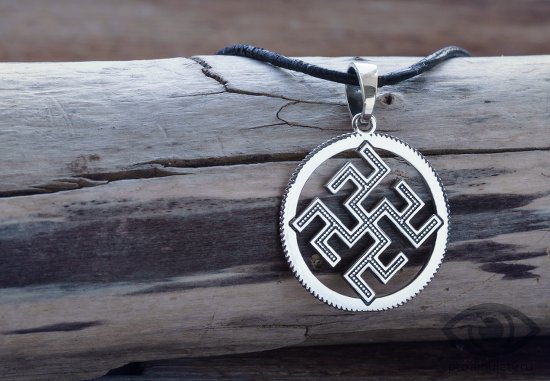
The Overpowering Grass amulet helped to recover from many illnesses and recover faster from illnesses
The Overcoming Grass symbol prevented diseases or helped get rid of them as quickly as possible. The Yarovik sign was placed everywhere; it was responsible for the safety of the harvest, protecting the house and livestock.
Slavic amulet of Rod
The Slavs attached special significance to some signs. For example, Rod is a symbol of the beginning, the birth of the Earth and man. They took him very seriously. It meant the unity of the human race, the connection between ancestors and descendants through the transfer of knowledge and wisdom that does not go beyond the boundaries of the race. Sometimes he was depicted as a laughing sun with numerous rays, at the end of which there were balls.

Amulet Symbol of the Family - the personification of the creative principle, it carries only positive energy
Amulets of the ancient Slavs
Natalya Florinskaya
Slavic embroidery
Charms of the ancient Slavs in folk embroidery
Our distant ancestors, as you know, worshiped the forces of nature. The amulets of the ancient Slavs are, in fact, a whole science associated with pagan deities. You can find protective symbols everywhere - from signs depicted on household items to clothing and accessories. Embroidery played a special protective role. Today we see in it only folk ornaments decorating clothes. However, this is far from true: each embroidered pattern carried certain information designed to help in solving important life problems.
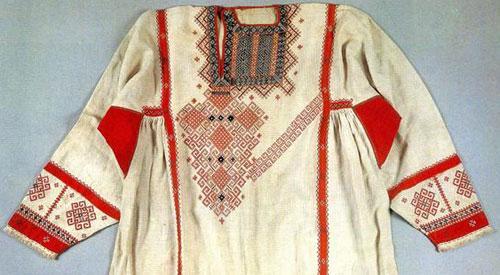
Places of embroidery on clothes
Folk embroidery decorated not only clothes, but also table and bed linen. At the same time, the location of the pattern, its color, the design, and the execution process itself mattered. So, on clothes, the ornament was traditionally located in a circle - on the hem, on the belt, on the sleeves, on the collar. The main purpose of embroidery was not decoration, as is commonly thought, but protection from damage and other evils.

Fragment of embroidery with solar ornament
Rules for embroidery
The amulets of the ancient Slavs in folk embroidery required strict adherence to a number of rituals even at the preparatory stage. The embroidery itself should not have knots on the reverse side, since knots, according to legend, deprived the amulet of its power. Here are some rules that had to be followed when performing protective embroidery:
1. You cannot embroider a talisman for yourself. 2. The amulet is performed exclusively at will and from the heart. You cannot force or ask someone to create a talisman for yourself. 3. The most powerful amulets are carried out by blood relatives - parents, children, brothers and sisters. Amulets created by the hands of one of the spouses are endowed with similar power, provided that the relationship is harmonious. 4. The choice of material that serves as the basis for the amulet must be in harmony with the person for whom it is intended. 5. In the process of making a talisman, you should think about who it is intended for, mentally imagining his image and feeling his energy, character and needs.
Only with strict observance of all these rules will the amulet have protective power and protect its owner from many misfortunes.

Slavic symbols - amulets
Interpretation of symbols
At first glance, many of the patterns appear to be the same. For example, the external similarity of such amulets as “fern flower” and “grass overcomer” or “caroler” and “Ladinets” can mislead an uninformed person who will mistake them for the same symbols. The difference lies in the direction of the rays of the pattern. The main part of the amulets are solar signs, that is, various versions of the swastika, which also affects their similarity.
Below are some of the symbols of Slavic amulets and their purpose.
Kolyadnik- personifies the god Kolyada. It means change for the better, renewal, victory of good. Male sign, giving strength in victory over the enemy, and in creative work.
Molvinets- provides protection from evil word, generational curse, evil eye and other types of damage. Grants the ability of eloquence.
Kolovrat- symbolizes the rising sun, as the eternal victory of Light over darkness. Its meaning also depends on the color with which this sign is depicted: red - rebirth, blue - renewal, black - change.
Cross of Lada - Mother of God, Ladinets- represents happiness and harmony in the family. Female sign from the evil eye. Often it was inscribed in a circle to give it more power.
Colard- refers to wedding symbols. Newlyweds were given jewelry with his image so that the family union would be strong and the offspring healthy.
Fern flower (Perunov color)- another fire amulet, symbolizing the purity of the Spirit. A sign with healing power is called upon to fulfill wishes. Helps to reveal the spiritual powers of a person.
Overcome-grass- a symbol designed to protect against various ailments. It was believed that, as a double fire sign, this symbol was able to destroy any disease with fire and cleanse the soul and flesh.
Swastika- the eternal universal cycle, personifying the Supreme Law, to which everything that exists is subordinated. The symbol is designed to protect Heavenly law.
Solard- wedding symbolism, signifying the prosperity and wealth of the family in the name of descendants and for the glory of the gods and ancestors.

Slavic symbols - amulets
England- the life-giving Fire of Creation, from which the Universe and all things appeared. Symbolizes divine Purity - the basis for protecting the World from the forces of Darkness.
Soul swastika- a symbol of the concentration of Higher healing powers. The clothing ornament was made exclusively by Priests who had risen to the Highest level of spiritual perfection.
Spiritual swastika- a sign that personifies the harmony of soul and body. An unchanging attribute of Magi and magicians, giving strength to control the elements of nature.
Doukhobor- personifies the inner life fire that destroys physical and spiritual ailments in a person. The sign was applied to the material with which the patient was covered.
Spiritual Power- the symbol was used to enhance the concentration of spiritual and physical forces necessary to accomplish great deeds for the benefit of descendants and one’s people.
Znich- a sign of the fire god guarding the sacred Living Fire - an inexhaustible source of life.
Bunny- a solar sign representing renewal. It was believed that a woman wearing a belt with the image of a symbol would give birth to boys - successors of the family.
Duniya- Merging of heavenly and earthly living fire. Designed to preserve the paths of constant unity of the clan. The shape of this sign served as the basis for the construction of fire altars.
Velesovik- a symbol that protects a loved one who is away from home, from various adversities and elements of nature.
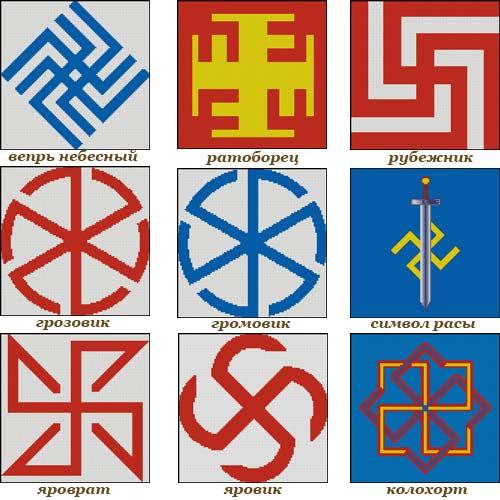
Slavic symbols - amulets
Gromovik- a symbol of the god Indra - the keeper of the ancient heavenly wisdom of the gods. It was often applied to military armor and weapons, and was also depicted at the entrance to vaults. It was believed that every enemy would be struck by thunder.
Thunderstorm- used as a sign that makes it possible to control the forces of nature. As a talisman, the image of the symbol was intended to protect homes and temples from various misfortunes.
Boar of Heaven- symbolizes the fusion of past and future, earthly and heavenly wisdom. It was applied to the clothes of people who had embarked on the path of spiritual self-improvement.
Yarovik- a sign displayed in front of the entrance to crop storage areas or places where livestock are kept. It was believed that this symbol helped preserve the harvest and protect livestock from death.
Yarovrat- a sign of Yaro-god, the manager of favorable weather conditions for growing grain crops. The image of the symbol can be found on agricultural tools.
Race Symbol- a sign that protects great nations from various evil forces and enemies, protecting earthly wisdom. The symbol means the unification of the Aryans and Slavs - the great races.
Rubezhnik- personifies the universal boundary, serving as a threshold between earthly life and the afterlife. Depicted in front of the entrance to the Temple and Sanctuary.
Kolohort- a sign that personifies the eternal cycle of opposites - life and death, good and evil, wisdom and stupidity. Used in cases where it was necessary to resolve a dispute.
Ratiborets- the personification of military valor and courage. Applied to military armor, weapons, banners and banners. According to legend, this sign is capable of blinding the enemy and forcing him to flee from the battlefield.
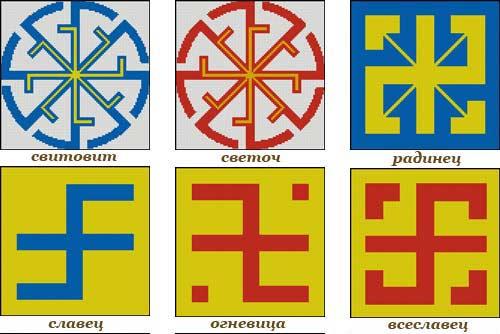
Slavic symbols - amulets
Slavets- a female symbol that gives girls and women health, and married women - healthy offspring. The sign can often be found in embroidery decorating women's clothing.
Ognevitsa- a sign that protects married women from evil forces. Often found in clothing embroidery mixed with other protective symbols.
Radinets- a symbol that protects babies from damage and the evil eye, giving them peace. Depicted on children's cradles and cradles.
Vseslavets- a sign that protects homes and granaries from fires, families from disagreements, neighbors from civil strife. A symbol, according to legend, leading all Clans to harmony and unity.
Beacon- a symbol that unites two great fiery streams: Divine and Earthly, as a result of which a Universal whirlwind of transformation is born, which helps a person discover the meaning of existence.
Svitovit- the eternal relationship between the elements of heavenly fire and earthly water. Women preparing to become mothers embroidered this sign on their clothes. The symbol represented the birth of a pure soul.
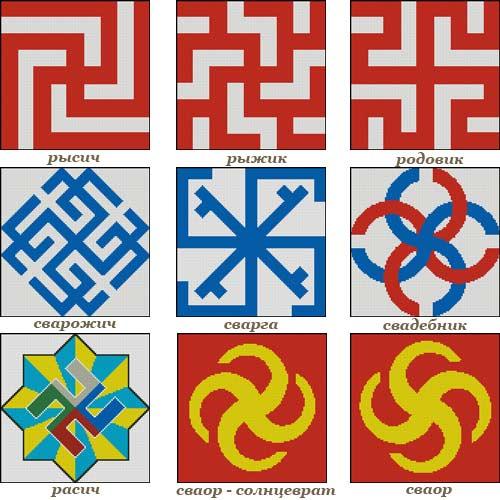
Slavic symbols - amulets
Svarozhich- a symbol that protects the individual from degradation, supporting everything reasonable. A sign of the power of the god Svarog - the guardian of the diversity of life forms in the Universe.
Svarga- sign spiritual ascent on the way to perfection.
Swaor - solstice- marks the movement of Yarila the sun across the firmament. Encourages purity of thoughts and spiritual insight.
Swaor- symbolizes the constant celestial movement and the circulation of the vital forces of the Universe. Swaor, applied to household items, means, according to legend, prosperity and well-being in the house.
Wedding party- The strongest family amulet, meaning the fusion of two genera, masculine and feminine, into a single life system.
Rysich- is considered the most powerful amulet against the forces of Darkness. In ancient times it was depicted on the walls of Sanctuaries and Temples, on stones near altars. Later it began to be applied to any buildings.
Austinite- in everyday life it was called "Bulletin". It was believed that it protected not only people, but also livestock and poultry from harm. The sign was also depicted on agricultural implements in order to improve the growth of crops, increasing the harvest.
Salting- A sign symbolizing the setting sun, retiring, Yarila. Represents the completion of creative work, the spiritual resilience of man and the peace of nature.
Rodimych- A sign that personifies the continuity of generations and reliably preserves ancestral memory.

Slavic symbols - amulets
Rodovik- marks the support and help of ancestors and progenitors to those who work for the benefit of their descendants.
Rasic- A sign of the unity and power of the great families of Races: yes "Aryans, x" Aryans, Svyatorus and Rassenov.
Ryzhik- a symbol of bountiful harvest and fertility. It was depicted above the entrance to harvest storages, and was also applied to agricultural tools.
Fireman- a fiery sign of God Rod, often found on platbands, shutters, slopes of house roofs, and on the ceilings of buildings.
Oberezhnik- A sign that brings happiness, health and joy. Ancient amulet guardian of good luck and happiness.
Novorodnik- The sign is often present in the ornament of women's clothing. It is considered a powerful protective symbol that gives multiplication to the family.
Navnik- the personification of a person’s spiritual paths after death, which lead to his native heavenly world, where the soul came from.
Heavenly cross- used as a body amulet, giving a person the care and help of the ancestors of his family.
Charovrat- a symbol that protects a person from the effects of evil spells. It was believed that the fire of this sign burns away dark forces.
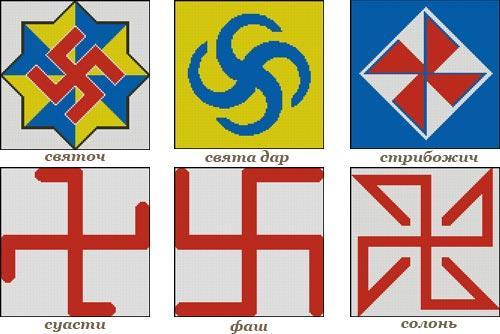
Slavic symbols - amulets
Fache- a symbol that protects a person from base thoughts and selfishness. Signifies the victory of reason over the forces of darkness and ignorance.
Suasti- marks the cycle of life on earth, eternal rotation. Symbolizes the four cardinal directions, the four northern rivers flowing in ancient Daria.
Sviatoch- symbolizes spiritual insight and the revival of the great race, connecting Illumination and Spirituality - the Golden and Heavenly Cross.
Stribozhich- a sign symbolizing the god Stribog, who commands hurricanes and winds. A symbol that protects homes and granaries from the effects of bad weather, giving sailors and fishermen a calm water space. Windmills were built in the form of this symbol so that the mills would not stand idle.
Holy gift- personifies Daria - the ancient server ancestral home of the white peoples, located in the Northern Ocean and perished after the first flood.


